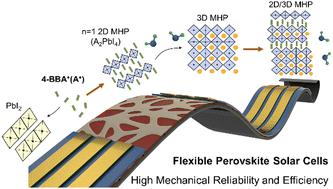当前位置:
X-MOL 学术
›
Energy Environ. Sci.
›
论文详情
Our official English website, www.x-mol.net, welcomes your
feedback! (Note: you will need to create a separate account there.)
Polarity and moisture induced trans-grain-boundaries 2D/3D coupling structure for flexible perovskite solar cells with high mechanical reliability and efficiency
Energy & Environmental Science ( IF 32.4 ) Pub Date : 2022-10-12 , DOI: 10.1039/d2ee01879a Ying Yan 1 , Ruiting Wang 1, 2 , Qingshun Dong 2 , Yanfeng Yin 3 , Linghui Zhang 4 , Zhenhuang Su 5 , Chenyue Wang 5 , Jiangshan Feng 6 , Minhuan Wang 4 , Jing Liu 4 , Hongru Ma 2 , Yulin Feng 4 , Wenzhe Shang 2 , Zhiyong Wang 1, 2 , Mingzhu Pei 2 , Yudi Wang 2 , Shengye Jin 3 , Jiming Bian 4 , Xingyu Gao 5 , Shengzhong Liu 6, 7 , Yantao Shi 2
Energy & Environmental Science ( IF 32.4 ) Pub Date : 2022-10-12 , DOI: 10.1039/d2ee01879a Ying Yan 1 , Ruiting Wang 1, 2 , Qingshun Dong 2 , Yanfeng Yin 3 , Linghui Zhang 4 , Zhenhuang Su 5 , Chenyue Wang 5 , Jiangshan Feng 6 , Minhuan Wang 4 , Jing Liu 4 , Hongru Ma 2 , Yulin Feng 4 , Wenzhe Shang 2 , Zhiyong Wang 1, 2 , Mingzhu Pei 2 , Yudi Wang 2 , Shengye Jin 3 , Jiming Bian 4 , Xingyu Gao 5 , Shengzhong Liu 6, 7 , Yantao Shi 2
Affiliation

|
To commercialize flexible perovskite solar cells (f-PSCs), they must achieve mechanical reliability along with high power conversion efficiency (PCE) and long-term stability. 2D/3D stacking of perovskites can theoretically improve the photovoltaic performance and mechanical reliability of f-PSCs simultaneously. But due to the complexity of the surface reaction, it remains a significant challenge to precisely control the growth of 2D perovskites with favorable growth sites, morphologies, and mechanical properties on 3D perovskites. Here we report the polarity of X-bromobenzylamine (X = 2, 3, and 4) salts as well as ambient moisture to be critical factors governing the reaction selectivity and growth behavior of 2D perovskites on 3D perovskites. The mild polarity-induced reaction selectivity, namely 4-bromobenzylamine cations with PbI2, enables precise growth of 2D perovskites at the grain boundaries (GBs) of 3D perovskites, while moderate moisture further stimulates the growth of 2D perovskites to form a trans-GBs structure. This unique “trans-GBs” 2D perovskite forms a p–n heterojunction with 3D perovskites, enhancing the built-in potential and exhibiting an excellent passivation effect and suitable mechanical properties (with the Young's modulus comparable to that of 3D MHP). As a result, the trans-GBs 2D/3D based f-PSCs obtained a certified PCE of up to 22.1% and maintained ∼80% of their initial PCE after 8000 bending cycles (R = 4 mm).
中文翻译:

极性和水分诱导的跨晶界 2D/3D 耦合结构用于具有高机械可靠性和效率的柔性钙钛矿太阳能电池
为了将柔性钙钛矿太阳能电池 (f-PSC) 商业化,它们必须实现机械可靠性以及高功率转换效率 (PCE) 和长期稳定性。钙钛矿的 2D/3D 堆叠理论上可以同时提高 f-PSC 的光伏性能和机械可靠性。但由于表面反应的复杂性,精确控制 2D 钙钛矿在 3D 钙钛矿上具有有利的生长位点、形态和机械性能的生长仍然是一个重大挑战。在这里,我们报告了X -溴苄胺的极性( X= 2、3 和 4) 盐以及环境水分是控制 2D 钙钛矿在 3D 钙钛矿上的反应选择性和生长行为的关键因素。温和的极性诱导反应选择性,即 4-溴苄胺阳离子与 PbI 2,使 2D 钙钛矿能够在 3D 钙钛矿的晶界 (GBs) 精确生长,而适度的水分进一步刺激 2D 钙钛矿的生长形成反式 GBs结构体。这种独特的“trans-GBs”二维钙钛矿形成了一个p - n与 3D 钙钛矿的异质结,增强了内建电位并表现出优异的钝化效果和合适的机械性能(杨氏模量与 3D MHP 相当)。结果,基于 trans-GBs 2D/3D 的 f-PSC 获得了高达 22.1% 的认证 PCE,并在 8000 次弯曲循环(R = 4 mm)后保持其初始 PCE 的约 80%。
更新日期:2022-10-12
中文翻译:

极性和水分诱导的跨晶界 2D/3D 耦合结构用于具有高机械可靠性和效率的柔性钙钛矿太阳能电池
为了将柔性钙钛矿太阳能电池 (f-PSC) 商业化,它们必须实现机械可靠性以及高功率转换效率 (PCE) 和长期稳定性。钙钛矿的 2D/3D 堆叠理论上可以同时提高 f-PSC 的光伏性能和机械可靠性。但由于表面反应的复杂性,精确控制 2D 钙钛矿在 3D 钙钛矿上具有有利的生长位点、形态和机械性能的生长仍然是一个重大挑战。在这里,我们报告了X -溴苄胺的极性( X= 2、3 和 4) 盐以及环境水分是控制 2D 钙钛矿在 3D 钙钛矿上的反应选择性和生长行为的关键因素。温和的极性诱导反应选择性,即 4-溴苄胺阳离子与 PbI 2,使 2D 钙钛矿能够在 3D 钙钛矿的晶界 (GBs) 精确生长,而适度的水分进一步刺激 2D 钙钛矿的生长形成反式 GBs结构体。这种独特的“trans-GBs”二维钙钛矿形成了一个p - n与 3D 钙钛矿的异质结,增强了内建电位并表现出优异的钝化效果和合适的机械性能(杨氏模量与 3D MHP 相当)。结果,基于 trans-GBs 2D/3D 的 f-PSC 获得了高达 22.1% 的认证 PCE,并在 8000 次弯曲循环(R = 4 mm)后保持其初始 PCE 的约 80%。











































 京公网安备 11010802027423号
京公网安备 11010802027423号